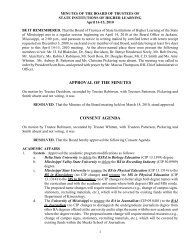Motor Vehicle And Fleet Management Best Practice Guidelines
Motor Vehicle And Fleet Management Best Practice Guidelines
Motor Vehicle And Fleet Management Best Practice Guidelines
Create successful ePaper yourself
Turn your PDF publications into a flip-book with our unique Google optimized e-Paper software.
What makes 15-passenger vans so dangerous? Begin answering this by recognizingthat these vans were originally designed to haul cargo - not people. Therefore, many ofthe safety features associated with typical passenger vehicles (like mini-vans, orbusses) was omitted. In fact, 15-passenger vans are more like trucks, while mini-vansare more like cars. They have truck chassis, truck suspensions, truck tires, and truckengines. Mini-vans are built on car chassis, with car suspensions and tires and engines.The 15-passenger vans are higher off the ground, longer, taller, heavier, have lessvisibility, and are more powerful than typical passenger vehicles. Add the weight of 15people and some gear and you’ve got quite a truck-driving job ahead of you. Whoever isdriving needs to be skilled, trained, and experienced.Why can’t we load them to maximum capacity? The center of gravity of an empty van isalready higher than most passenger vehicles. The risk of having a roll-over crash isabout the same as for a pick-up truck, while the van is empty. As you add passengers,you add weight above the axles. If you pack the rear of the van first, you add weightbehind the rear axle, shifting the center of gravity not only upward, but to the rear. Thisresults in less ground pressure at the front, where you count on the front tires to steerwith. The NHTSA report cited earlier stated that by the time you have ten people onboard, you’ve tripled the risk of rollover that you had with only a driver on board. Fill allfifteen seats and the risk is now five times greater. Add in the difficulty in steeringbecause your front wheels are barely touching the ground (and may even be coming offthe ground if driving over bumps), and the risk is unacceptable.Why all the focus on tires? Tire failure has been cited in many of the fatal crashesassociated with these vans. With a vehicle weighing over 9,000 pounds, tires need to beabove average. Manufacturers specify that light-truck (LT) tires are to be used for thesevehicles rather than passenger (P) tires. The LT tires have many different qualities butthe ability to take the weight and turn corners with it are two important ones. KenTestorff, in a report he wrote for the U.S. Navy states that “a random check ofgovernment-owned and leased 15-passenger vans in mid-2001 revealed some hadimproper replacement tires installed. When tires don’t meet the manufacturer’sminimum standards for size, pressure, and load, you’re asking for problems. Heatrapidly builds up in such cases, creating the potential for tire failure, which can cause adriver to lose control and wreck.”Tire pressure, even with the proper tires, must be checked with a gauge and adjusted tothe tire and vehicle specifications. If you have the correct tires, this should be the samefor both. Begin by checking the federal certification sticker usually found on the driver’sdoor pillar. This lists the vehicle’s gross weight load limits (per axle), required tire typeand size, and cold inflation pressure for front and rear tires. Compare this to the tiresthat are actually on the van. If sub-standard tires are present, they should be replacedprior to further use. Note that the pressures usually differ from front to rear. The front isusually about 50 p.s.i. while the rear is usually about 80 p.s.i. Only a good tire pressuregauge will tell you if you need more air.Why are 15-passenger van wrecks so often fatal? Eighty (80) percent of those who diedin 15-passenger van crashes were not wearing their seat-belts. Even people whonormally wear seat-belts don’t feel the need, or don’t remember, to wear them when<strong>Motor</strong> <strong>Vehicle</strong> and <strong>Fleet</strong> <strong>Management</strong> <strong>Best</strong> <strong>Practice</strong> <strong>Guidelines</strong> 23
















